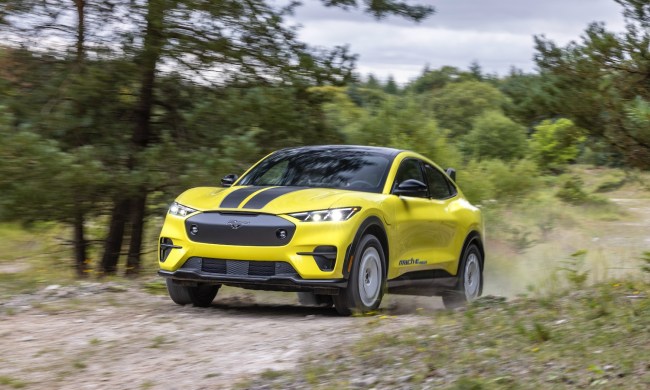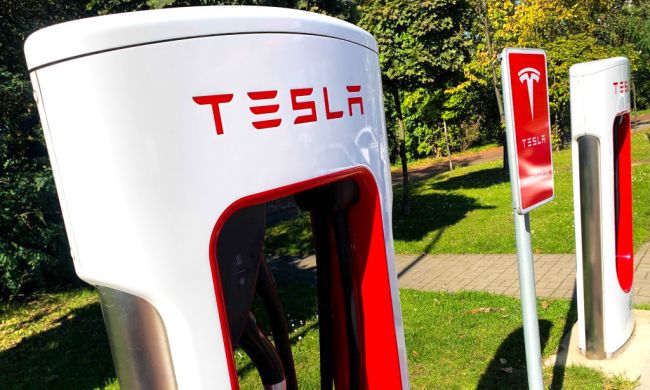When it hits showrooms later this year, the redesigned 2015 Ford Mustang will have plenty of rivals. From Detroit pony cars like the Chevrolet Camaro to muscle cars like Dodge Challenger to more effete German sport coupes, everyone’s got the Mustang’s number.
However, the new Mustang’s biggest rival might be itself.
The 2015 model year brings more changes than this car has seen in decades, and some are quite controversial. As Ford tries to broaden the Mustang’s appeal, it risks diluting the qualities that made it a fan favorite in the first place.
Exterior design
Prior to the 2015 Mustang’s unveiling back in December, there were rumors that it ditch the previous model’s retro styling for a more modern look inspired by the Ford Evos concept. This caused much consternation in Mustang land.
The finished product is actually much closer to the 2014 model than originally thought, although the word “retro” no longer adequately describes it.
Important Mustang cues – such as the grille, fastback silhouette, and taillights – remain, but Ford’s designers also made the 2015 sleeker, and more muscular.
The Fusion-esque headlights are an immediately apparent difference in photos, but in real life the 2015 model appears much sportier and visually slimmer than the 2014. The latter’s bulk was its only real aesthetic flaw.
While it may not win over everyone, the 2015 Mustang’s styling is a definite improvement over the 2014’s design.
Interior design, comfort, amenities
The 2015 Mustang received a less-dramatic interior redesign as well. As with the exterior, the retro cues are toned down to give the cabin a more modern look.
Overall, the new interior feels a bit more sports car than muscle car, but should still be familiar to anyone stepping out of the 2014 Mustang.
Both cars feature a ton of optional technology, including selectable driving modes, Sync with AppLink connectivity, and Track Apps that record acceleration times, braking performance, and g-forces.
So while the new interior is an improvement, it’s not quite dramatic enough to give the 2015 Mustang the edge over last year’s pony.
Powertrain
The 2015 Mustang retains the 2014’s powertrain options, but with one major exception.
Another controversial move by Ford was the addition of a 2.3-liter EcoBoost turbocharged four-cylinder engine to the lineup.
While a four-cylinder Mustang might seem wrong to some, Ford has offered them before (the last in 1993) and with a projected 300 horsepower and 305 pound-feet of torque, the EcoBoost should offer plenty of power with improved fuel economy.
Otherwise, Ford will offer the same 3.7-liter V6 and 5.0-liter V8 as the previous model. The V6 is expected to produce 300 hp and 270 lb-ft for 2015, down slightly from the 2014 model’s 305 hp and 280 lb-ft.
The “Coyote” V8’s output of 420 hp and 390 lb-ft is expected to be unchanged for 2015. Ford has reworked both the six-speed manual and automatic transmissions for 2015, with paddle shifters for the latter.
With last year’s competent powertrains still in the lineup along with a third, more fuel-efficient option, the 2015 Mustang is ahead by a nose here.
Performance
Performance figures for the 2015 Mustang will have to wait, but there is some new hardware that should make the new car a major improvement over the old.
The new Mustang has independent-rear suspension in place of the 2014’s solid axle, which was as much of a throwback to the 1960s as the styling.
Despite protests from a very vocal segment of Mustang fans, the switch to an independent rear has seemed inevitable for some time, and rightfully so. In the 21st century, muscle cars need to be at home on road courses as well as drag strips.
Speaking of drag strips, Ford has also made electronic line lock standard equipment on the V8-powered Mustang GT.
This allows the driver to easily do a burnout – a necessary part of drag-race prep – by locking the front brakes. Granted, actually racing a new Mustang will void the warranty.
The improved suspension alone should make the 2015 Mustang superior to the 2014, while the line-lock feature should be good for a few bar boasts.
Keep in mind that there is also at least one performance version of the new Mustang in development, slated to replace the outgoing Shelby GT500. Rumor has it that this model will wear GT350 or Mach 1 badging.
Price
Pricing for the 2015 Mustang is still a question mark, although it’s likely the EcoBoost four-cylinder will cost more than the V6, with the V8 remaining on top.
However, for most people the price difference between these two will probably be that between a brand-new car and a lightly-used example.
So Mustang buyers will have the choice of saving a few bucks on an older model, or spending the extra money for a warranty, all the new features, and that new car smell.
Either option seems sensible.
Cool factor
The 2014 Mustang is no wallflower, but the 2015 car’s more dramatic styling will definitely draw more attention on the street. Plus, it’s the new car, which means it will get the lion’s share of attention for the moment.
It’s hard to think of anything cooler than a radically-redesigned Mustang being unveiled for the car’s 50th anniversary, and that’s exactly what we car people are enjoying right now.
Once the reviews are written and the first cars start coming off lease, though, it’s hard to say.
The 2014 Mustang turned out to be a great performance car as well as a style icon and, while it’s hard not to imagine the 2015 developing a similar reputation, it still has to prove itself.


